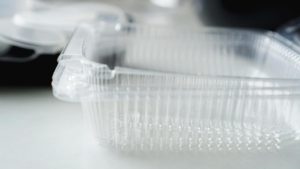At a Glance
- Sustainable packaging terms are often misused, and each one requires different disposal systems.
- Infrastructure is the real barrier, not the materials themselves.
- Bio-based doesn’t mean biodegradable — and many don’t break down at all.
- No one-size-fits-all — your best option depends on product needs and local systems.
You’re standing in your office, staring at samples of packaging materials spread across your desk. Your customers are demanding more eco-friendly options, including sustainable packaging. Your CEO wants to know which direction will help future-proof the business (preferably yesterday). Regulatory pressures are rising quickly in many states. It’s happening faster than you can say “extended producer responsibility.”
Meanwhile, your packaging supplier sent a catalog written by someone who swallowed a chemistry book. It’s filled with confusing acronyms.
Sound familiar? You’re not alone — and you definitely need more coffee.
Food industry professionals all over the country are facing a key challenge. They need to navigate sustainable packaging while maintaining product quality, managing costs, and meeting consumers’ expectations. The terminology alone can be overwhelming — compostable, biodegradable, bio-based, recyclable — and the stakes couldn’t be higher.
This week, we interviewed Conor Carlin, President of Clefs Advisory LLC. Positioned at the crossroads of packaging and sustainability, Conor previously led the Society of Plastics Engineers as President in 2024 and formerly held the position of General Manager for ILLIG in North America. His specialization covers materials, packaging technologies, policy, commercial strategy, and market intelligence.
This article simplifies sustainability language and offers practical tips for your packaging choices. We’ll break down compostable, recyclable, bio-based, and biodegradable options and show the real infrastructure behind them that marketing often ignores. Finally, we’ll give you a simple framework to make decisions that really work. No PhD in polymer science is required.
A Sustainability Maze Without Clear Signposts

The packaging sustainability world has mixed messages, confusing rules, and uncertain consumers. Terms like “compostable” and “biodegradable” are often used interchangeably but differ fundamentally. There’s also bio-based materials which may or may not be biodegradable! Recyclable options have their own challenges. Acceptance rates and offerings vary by region. Some areas don’t even have recycling programs at all!
As a food industry professional, you must make smart choices that balance many priorities:
- Product protection and shelf-life extension
- Cost considerations and budget constraints
- Environmental impact and corporate responsibility
- Consumer preferences and market positioning
- Regulatory compliance across different jurisdictions
The problem isn’t just picking options. It’s also about knowing what each option means and how it works in real life.
Breaking Down the Terminology
Let’s clarify these terms before choosing the best option for your business. Just like in a recipe for your culinary creations, it’s all about the details.
Recyclable
 Recyclable packaging seems straightforward, but the reality is more nuanced. Polyethylene Terephthalate (PET) is a strong, clear, and lightweight material commonly used for packaging fresh food. It has great barrier properties and resists impacts well. Still, its recyclability relies on local recycling facilities and market needs.
Recyclable packaging seems straightforward, but the reality is more nuanced. Polyethylene Terephthalate (PET) is a strong, clear, and lightweight material commonly used for packaging fresh food. It has great barrier properties and resists impacts well. Still, its recyclability relies on local recycling facilities and market needs.
The recycling landscape varies dramatically across the country. What’s accepted in one municipality might be rejected in another. Some areas have strong collection and processing systems. Others face contamination problems due to inconsistent sorting or poor public education and lack markets for recycled materials due to low demand or insufficient infrastructure. And as mentioned above, there are areas where no recycling programs exist.
Recyclable packaging has a big advantage: the dream of circularity. This means materials stay in use and don’t just become waste. This works only if the whole system functions well, from collection to processing to market demand.
Bio-based
Simply put, bio-based materials are those that are made from non-fossil resources. In other words, they are made from corn or sugarcane instead of hydrocarbons derived from oil or gas processing. But just because they are made from natural or “bio-based” materials, it does not necessarily mean they are biodegradable. Polyethylene made from sugarcane (“Green PE”), produced by Braskem, does not biodegrade. Polylactic acid (PLA), made from corn and produced by NatureWorks and Total Corbion, does indeed biodegrade — but only under very specific circumstances. Like everything else in this dilemma, however, there are trade-offs — notably, the current inability to collect, sort, and recycle (or compost) PLA at scale. Plant-based resins continue to be explored in the search for lower-carbon-footprint materials.
Biodegradable
Biodegradable packaging includes materials that decompose naturally. But it gets tricky: the environment plays a key role.
Biodegradation can occur in aerobic (with oxygen) or anaerobic (without oxygen) conditions. Most landfills create anaerobic conditions, which take a long time to complete. This slow process can result in methane, a strong greenhouse gas.
The important distinction is that biodegradation doesn’t automatically equal environmental benefit. The conditions for breakdown, the time it takes, and the byproducts produced all matter.
Compostable
 You might think that compostable packaging falls into the ’biodegradable’ category. However, there are several factors that can prevent the material from degrading. One of the most prominent reasons is that compostable packaging often contains plastic liners or ‘ride-along materials’ such as stickers and labels.
You might think that compostable packaging falls into the ’biodegradable’ category. However, there are several factors that can prevent the material from degrading. One of the most prominent reasons is that compostable packaging often contains plastic liners or ‘ride-along materials’ such as stickers and labels.
Compostable packaging has to meet certain standards and must be certified before any marketing claims can be made. For example, ASTM D6400 states that materials must biodegrade 90% within 180 days in controlled conditions. You read that correctly. The standards are THAT precise. This isn’t just marketing speak; it’s a rigorous certification process.
The catch is that compostable packaging only works if it gets to the proper composting facilities. Compostable materials don’t help the environment if they go to landfills.
Industrial composting facilities require specific temperature ranges, moisture levels, and turning schedules. Home composting works under different conditions. It may not break down industrially compostable materials well.
The Infrastructure Challenge
The biggest obstacle to sustainable packaging isn’t the materials themselves — it’s infrastructure. (Plot twist: the packaging isn’t the villain in this story.)
Imagine a restaurant chain that starts using compostable containers. They want to cut down on their environmental impact. Customers bring the containers home with good intentions. However, they usually end up in regular trash. This is mainly because residential composting programs are as rare as unicorns in most areas. The containers often end up in landfills. They don’t break down properly there. This means they might not help the environment much more than regular packaging. It’s like buying a sports car for city traffic — technically impressive but missing the point.
This infrastructure gap exists across all options:
- Recycling systems vary widely by region and material type
- Composting facilities are concentrated in certain areas with limited capacity
- Consumer education and participation rates remain inconsistent
The Economic Reality: Cost Considerations That Can’t Be Ignored

Sustainable packaging choices aren’t made alone. They are business decisions that need to consider money matters.
Recyclable materials, like PET, have strong supply chains and production methods and enjoy economies of scale. Alternative materials often cost more because they are produced in smaller quantities and use newer technologies. Once again, “cost” has shown up at the sustainability party, souring everyone’s mood.
However, the cost equation extends beyond material pricing. Consider factors like:
- Product protection and potential spoilage reduction
- Shelf life extension and inventory management
- Brand positioning and consumer willingness to pay premiums
- Regulatory compliance costs and potential future restrictions
- Supply chain reliability and availability
Making the Right Decision
Instead of seeing these options as rivals, consider them tools for various uses and situations.
Choose recyclable packaging when:
- You operate in regions with robust recycling infrastructure.
- Product protection and barrier properties are critical.
- Cost considerations are a primary factor.
- You can influence consumer disposal behavior through clear labeling.
Consider biodegradable options when:
- You have control over disposal conditions (this is rare).
- Barrier property requirements are minimal.
Evaluate compostable packaging when:
- You can ensure access to appropriate composting facilities.
- Your customers participate in composting programs.
- You’re willing to invest in consumer education.
- Product protection requirements align with material capabilities.
Practical Steps for Food Industry Professionals
 The sustainable packaging challenge won’t be solved quickly. But you can take clear steps to make smart choices:
The sustainable packaging challenge won’t be solved quickly. But you can take clear steps to make smart choices:
- Assess your local infrastructure: Research recycling and composting capabilities in your primary markets.
- Evaluate your product requirements: Understand barrier properties, shelf-life needs, and performance criteria.
- Think about the whole lifecycle: Don’t just focus on choosing materials. Also, consider transportation, storage, and what happens at the end of the product’s life.
- Collaborate with suppliers: Partner with packaging experts who know materials and focus on sustainability.
- Educate your customers: Provide clear disposal instructions and context for your packaging choices.
Wrapping It Up: There’s No Universal Solution
The best sustainable packaging choice depends on your situation, products, markets, customers, and values. Stop searching for the “perfect solution” — it’s like looking for the Tooth Fairy. Instead, make smart choices that help your business and the environment.
The goal isn’t perfection — it’s progress. Each choice you make helps transform how the food industry handles packaging sustainability. You’re not just solving a business problem but building a better food system. Think of it as GPS for sustainability — you might take a few wrong turns, but you’ll get there.
The best packaging choice fits your needs and helps you reach your goals. That’s not just good business — it’s good leadership.
Are you interested in learning more about food packaging and sustainability? Visit our Learning Center today!
Would you like to know more about Conor Carlin and his work at Clefs Advisory LLC? Connect with him on LinkedIn today.

